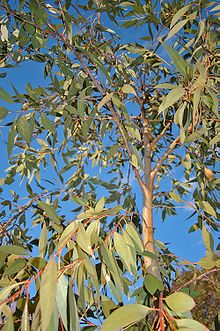Eucalyptus dives
Appearance
| Eucalyptus dives | |
|---|---|

| |
| Scientific classification | |
| Kingdom: | |
| (unranked): | |
| (unranked): | |
| (unranked): | |
| Order: | |
| Family: | |
| Genus: | |
| Species: | E. dives
|
| Binomial name | |
| Eucalyptus dives Schauer
| |
Eucalyptus dives or broad-leaved peppermint is a small tree native to temperate dry sclerophyll woodlands and forests of south-eastern Australia. The juvenile leaves are ovate and glaucus, and adult leaves are lanceolate to broad-lanceolate. Leaves are aromatic.
Uses
There are two notable chemotypes of E. dives: piperitone and cineole. The oil yield is high at 4.7% of the leaf fresh weight.
- The piperitone chemotype of E.dives has a peppermint like flavour and aroma. It is distilled for piperitone, which is used in the production of synthetic menthol. The major producing region is eastern Transvaal, South Africa, where it is grown in commercial plantations.[1] The leaves of the piperitone chemotype have also been used as a flavouring in Australia since colonial times, especially in combination with a brewed black Camellia sinensis 'billy tea'. This is the chemotype intended when none is specified [1]
- The cineole chemotype of E.dives is a generic type eucalyptus oil, and is harvested and distilled commercially. Cautionary note: If this chemotype exists, it is uncommon. The usual sources of cineole are eucalyptus globulus [2], [3] and Eucalyptus radiata [4], [5]
-
Pair of leaves: top-side and under-side
-
Juvenile foliage of piperitone chemotype, Eucalyptus dives
-
Flowers of Eucalyptus dives
-
Eucalyptus dives essential oil in clear glass vial
References
- ^ Cribb, A.B. & J.W., Useful Wild Plants in Australia, Collins 1982, p23, ISBN 0-00-636397-0
- Boland, et al., Eucalyptus Leaf Oils - Use, Chemistry, Distillation and Marketing, ISBN 0-909605-69-6.




